maintenance AUDI A3 CABRIOLET 2016 Owners Manual
[x] Cancel search | Manufacturer: AUDI, Model Year: 2016, Model line: A3 CABRIOLET, Model: AUDI A3 CABRIOLET 2016Pages: 272, PDF Size: 67.88 MB
Page 3 of 272
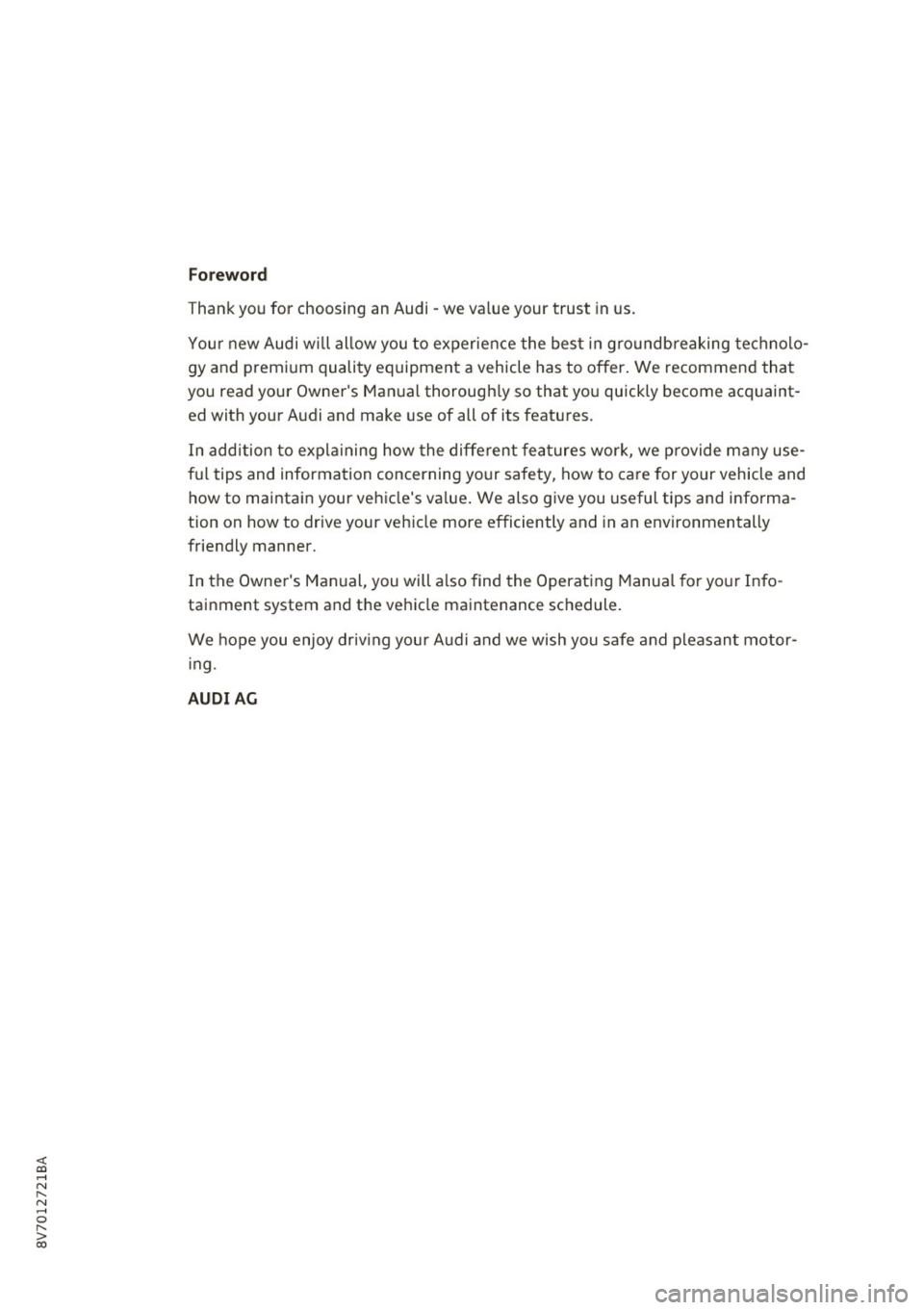
<( co .... N ,.__
N .... 0 ,.__
> co
Foreword
Thank you for choosing an Audi -we value your trust in us.
Your new Audi will allow you to experience the best in groundbreaking technolo
gy and premium quality equipment a vehicle has to offer. We recommend that
you read your Owner's Manual thoroughly so that you quickly become acquaint
ed with your Audi and make use of all of its features.
In addition to explaining how the different features work, we provide many use
ful tips and information concerning your safety, how to care for your vehicle and
how to maintain your vehicle's value . We also give you useful tips and informa
tion on how to drive your vehicle more efficiently and in an environmentally
friendly manner.
In the Owner's Manual, you will also find the Operating Manual for your Info
tainment system and the vehicle maintenance schedule.
We hope you enjoy driving your Audi and we wish you safe and pleasant motor
ing .
AUDIAG
Page 5 of 272
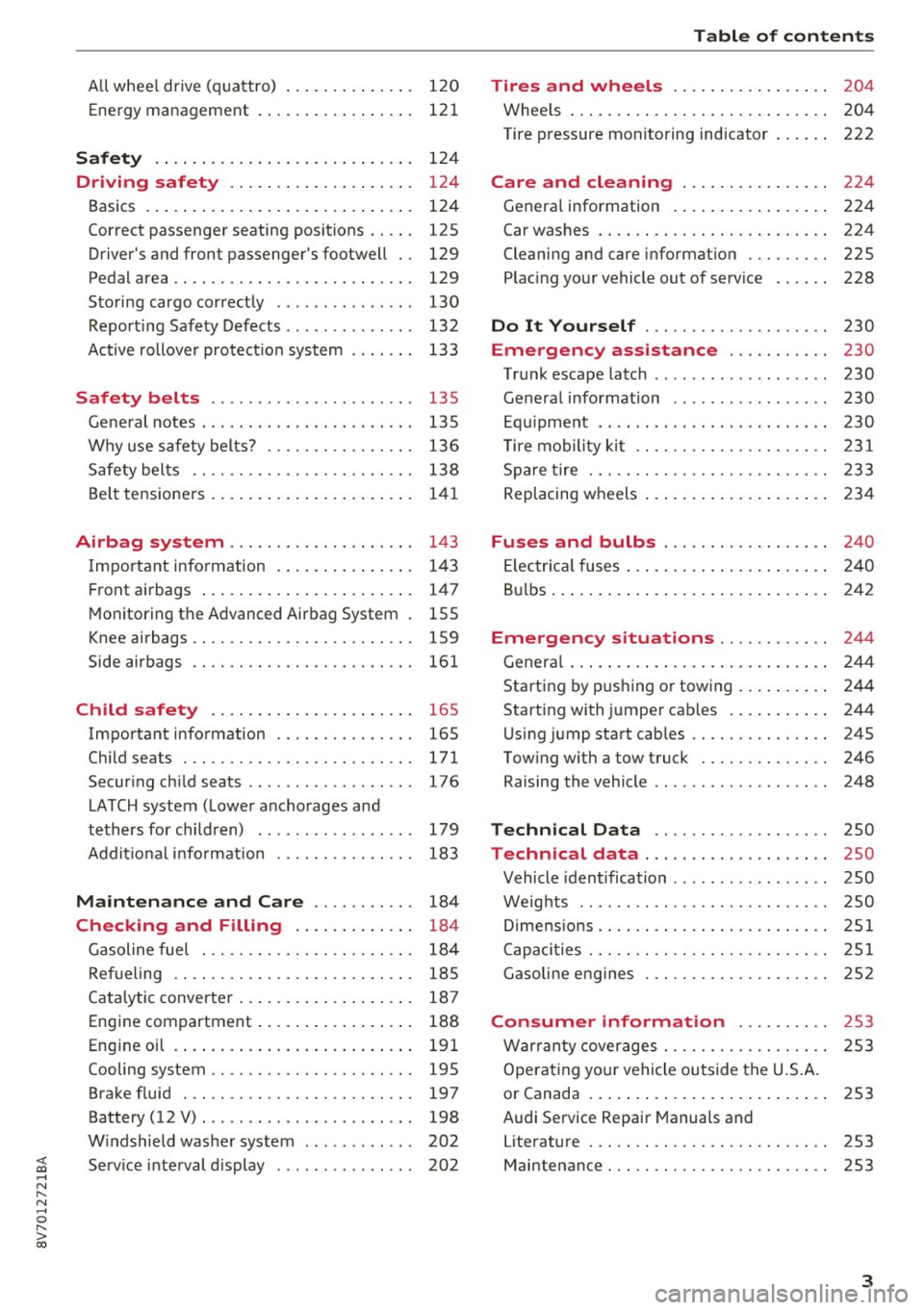
<( co .... N ,.__
N .... 0 ,.__
> co
All w hee l drive ( quattro) . . . . . . . . . . . . . . 120
Ene rgy management 121
Safety .. .. .. .. .. .. .... ... .. .. .... . 124
Driving safety . . . . . . . . . . . . . . . . . . . . 124
Basics . . . . . . . . . . . . . . . . . . . . . . . . . . . . . 124
Co rrect p assenge r seating positions . . . . . 125
Driver 's and front passenger 's footwell . . 129
Pedal area . . . . . . . . . . . . . . . . . . . . . . . . . . 129
S toring cargo co rrectly . . . . . . . . . . . . . . . 130
Repo rting Safe ty Defects . . . . . . . . . . . . . . 132
Active rollove r protect io n system 133
Safety belts . . . . . . . . . . . . . . . . . . . . . . 135
Ge neral notes . . . . . . . . . . . . . . . . . . . . . . . 13 5
Why use safety belts? . . . . . . . . . . . . . . . . 136
S afety bel ts . . . . . . . . . . . . . . . . . . . . . . . . 138
B el t tensione rs . . . . . . . . . . . . . . . . . . . . . . 1 41
Airbag system . . . . . . . . . . . . . . . . . . . . 143
I mpor tant info rm ation . . . . . . . . . . . . . . . 14 3
Fr ont airbags . . . . . . . . . . . . . . . . . . . . . . . 1 47
M oni toring th e Advanced Airbag System . 155
K nee airbags . . . . . . . . . . . . . . . . . . . . . . . . 159
Side airbags . . . . . . . . . . . . . . . . . . . . . . . . 161
Child safety . . . . . . . . . . . . . . . . . . . . . . 165
Important info rmation . . . . . . . . . . . . . . . 165
C hi ld seats . . . . . . . . . . . . . . . . . . . . . . . . . 171
Secur ing ch ild seats . . . . . . . . . . . . . . . . . . 176
L ATCH system ( Lowe r anchorages and
tethers for chi ldren) . . . . . . . . . . . . . . . . . 179
Addit io nal i nfo rmat ion . . . . . . . . . . . . . . . 183
Maintenance and Care . . . . . . . . . . . 184
Checking and Filling . . . . . . . . . . . . . 184
G asoline fuel . . . . . . . . . . . . . . . . . . . . . . . 184
Refueling . . . . . . . . . . . . . . . . . . . . . . . . . . 18 5
Cata lytic converter . . . . . . . . . . . . . . . . . . . 187
Eng ine compartment . . . . . . . . . . . . . . . . . 188
Eng in e oi l . . . . . . . . . . . . . . . . . . . . . . . . . . 191
Cooling system . . . . . . . . . . . . . . . . . . . . . . 195
Brake fluid . . . . . . . . . . . . . . . . . . . . . . . . . 197
Battery (12 V) . . . . . . . . . . . . . . . . . . . . . . . 198
W indshield was her system . . . . . . . . . . . . 202
Service inte rval display . . . . . . . . . . . . . . . 202
Table of contents
Tires and wheels . . . . . . . . . . . . . . . . .
204
Whee ls . . . . . . . . . . . . . . . . . . . . . . . . . . . . 204
Tire p ressure monitoring ind icator . . . . . . 222
Care and cleaning . . . . . . . . . . . . . . . . 224
G enera l information . . . . . . . . . . . . . . . . . 224
Car washes . . . . . . . . . . . . . . . . . . . . . . . . . 224
Cleaning and ca re i nformat ion . . . . . . . . . 225
Plac ing you r vehicle out of serv ice . . . . . . 228
Do It Yourself . . . . . . . . . . . . . . . . . . . . 230
Emergency assistance . . . . . . . . . . . 230
T ru nk escape latch . . . . . . . . . . . . . . . . . . . 230
Genera l information . . . . . . . . . . . . . . . . . 230
E q ui pment . . . . . . . . . . . . . . . . . . . . . . . . . 230
T ire mobility kit . . . . . . . . . . . . . . . . . . . . . 231
Sp are tire . . . . . . . . . . . . . . . . . . . . . . . . . . 233
Replacing w heels . . . . . . . . . . . . . . . . . . . . 2 34
Fuses and bulbs . . . . . . . . . . . . . . . . . . 240
El ec trica l fuses . . . . . . . . . . . . . . . . . . . . . . 2 40
B ul bs . . . . . . . . . . . . . . . . . . . . . . . . . . . . . . 2 42
Emergency situations . . . . . . . . . . . . 244
Genera l . . . . . . . . . . . . . . . . . . . . . . . . . . . . 2 44
Starting by p ush ing o r towing . . . . . . . . . . 244
Start ing with jumpe r cab les . . . . . . . . . . . 244
U sing jump sta rt cab les . . . . . . . . . . . . . . . 24S
Tow ing with a tow truck . . . . . . . . . . . . . . 246
Raising the vehicle . . . . . . . . . . . . . . . . . . . 248
Technical Data . . . . . . . . . . . . . . . . . . . 250
Technical data . . . . . . . . . . . . . . . . . . . . 250
Vehicle ident ification . . . . . . . . . . . . . . . . . 250
Weig hts . . . . . . . . . . . . . . . . . . . . . . . . . . . 250
Di mens io ns .. .. . .......... ... ..... .. 251
C apaci ties . . . . . . . . . . . . . . . . . . . . . . . . . . 251
Gasoline e ng ines . . . . . . . . . . . . . . . . . . . . 2S2
Consumer information . . . . . . . . . . 2S3
Warr anty cove rages . . . . . . . . . . . . . . . . . . 253
Operat ing yo ur vehicle outside the U.S.A.
o r Canada . . . . . . . . . . . . . . . . . . . . . . . . . . 253
Audi Se rvice Repair Manuals and
Literat ure . . . . . . . . . . . . . . . . . . . . . . . . . . 253
Maintenance. . . . . . . . . . . . . . . . . . . . . . . . 253
3
Page 7 of 272
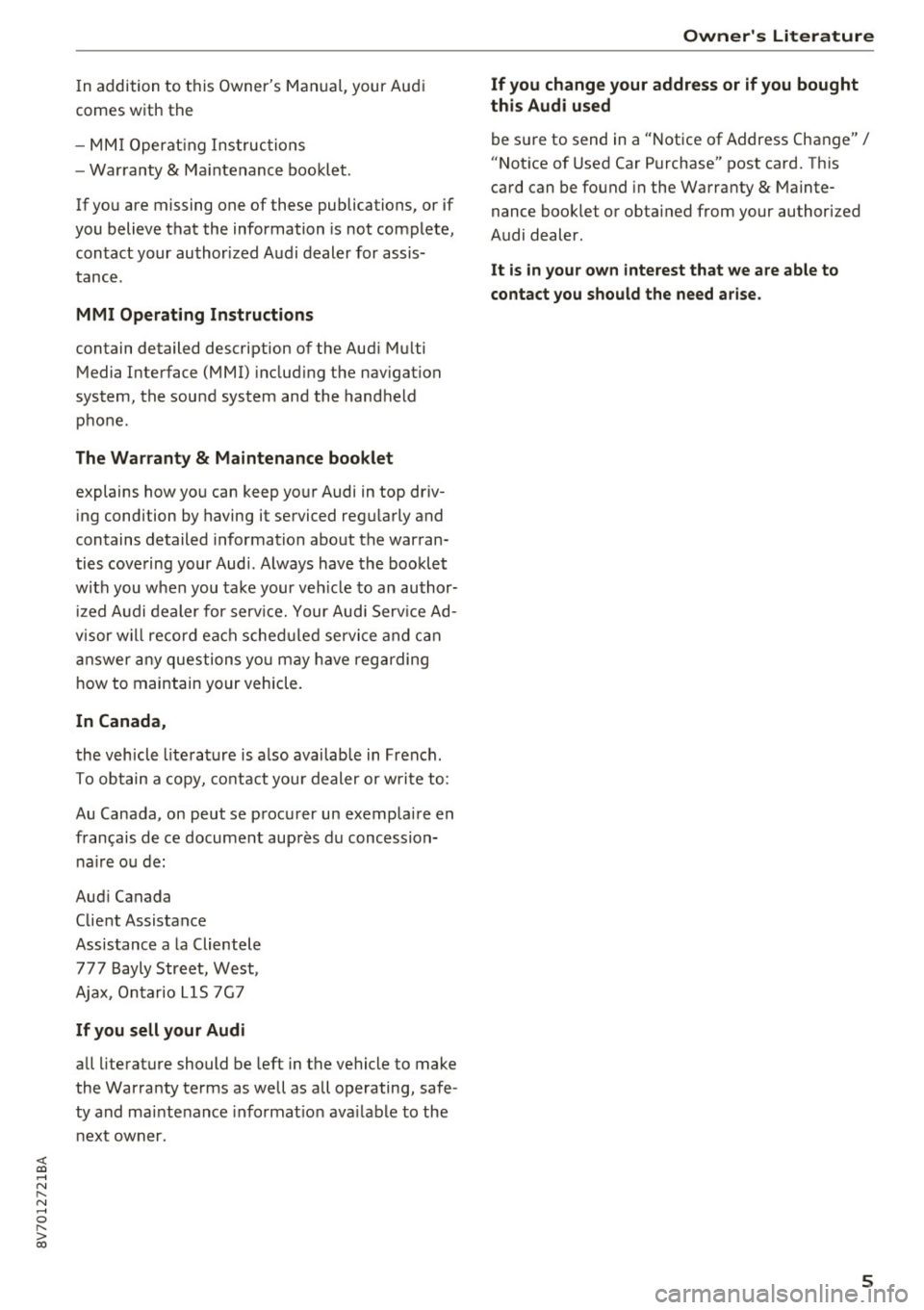
<( co .... N r--N .... 0 r--> co
In addition to this Owner's Manual, your Audi
comes with the
- MMI Operat ing Instructions
- Warranty
& Maintenance booklet.
If you are missing one of these publications , or if
you believe that the information is not complete,
contact your author ized Audi dealer for assis
tance .
MMI Operating Instructions
contain detailed description of the Aud i Mu lti
Media Interface (MMI) includ ing the nav igation
system, the sound system and the hand held
phone.
The Warranty & Maintenance booklet
explains how you can keep your Audi in top d riv
ing condition by having it serviced regu larly and
contains detailed information about the warran
ties covering your Aud i. Always have the booklet
with you when you take your veh icle to an author
iz ed A udi dealer for serv ice. Your Audi Serv ice Ad
visor w ill record each scheduled service and can
answer any questions you may have regarding
h ow to maintain your vehicle.
In Canada,
the vehicle literature is also available in French .
To obtain a copy, co nta ct you r dealer or write to:
Au Canada, on peut se procurer un exemplaire en
frarn;ais de ce document aupres du concession
naire ou de:
Aud i Canada
Client Assistance
Assistance a la Clientele
777 Bayly Street, West ,
Ajax, Ontario LlS 7G7
If you sell your Audi
all literature should be left in the vehicle to make
the Warranty terms as well as all operating, safe
ty and maintenance informat ion ava ilable to the
next owner.
Owner 's Literature
If you change your address or if you bought
this Audi used
be sure to send in a "Notice of Address Change" I
"Not ice of Used Car Purchase" post card. This
card can be found in the Warranty
& Mainte
nance booklet or obtained from your authorized
Audi dealer.
It is in your own interest that we are able to
contact you should the need arise.
5
Page 28 of 272

<( co .... N r--N .... 0 r--> co
Opening and closing
Central locking
Key set
Fig. 13 Your vehicle key set
The key set contains two remote control keys or
conven ience keys*. To fold the key out and back
in place, press the release button ¢
fig. 13
-arrow-.
Remote control key or convenience key
The convenience key* is a remote control key with
special functions ¢
page 30 and¢ page 70.
With the remote control key, you can lock and
unlock the vehicle centrally and start the engine.
Number of keys
You can check the number of keys ass igned to
your vehicle in the MMI. This allows you to make
sure you have received all of the keys when you
purchase a used vehicle . Select: the
I MENU I but
ton
> Car > Systems* control button > Program
med keys.
Replacing a key
If a key is lost, see an authorized Audi dealer or
authorized Audi Service Facility. Have
this key de
activated.
It is important to bring all keys with
you . If a key is lost, you should report it to your
insurance company.
Immobilizer
The immobilizer prevents unauthorized use of
the vehicle . The vehicle may not start if another
radio device such as a key for another vehicle or a
transponder is located on the key ring.
Opening and closing
Data in the remote control key or
convenience key
While driving, service and maintenance-relevant
data is continuous ly stored on your remote con
trol key or convenience key*. Your Audi service advisor can read out this data and tell you about
the work your vehicle needs.
A WARNING
--- Always take the vehicle key with you when
leaving the vehicle, even for a sho rt period
of tim e. This applies particularly when chil
dren remain in the vehicle. Otherwise the
children could start the engine o r operate
electrica l equipment such as power win
dows .
- Do not remove the key from the ignition
lock until the veh icle has come to a com
p lete stop. Otherwise, the steering lock
could engage suddenly and increase the risk
of an acc ident.
(D Tips
The operation of the remote control key can
be temporarily disrupted by interference from
transmitters in the vicinity of the vehicle
working in the same frequency range (for ex
ample, a cell phone or rad io equipment) .
Central locking system description
You can lock and unlock the vehicle centrally.
T here are different ways, depending on vehicle
equipment:
- Remote control key¢
page 29,
-Lock cylinder on the driver's door ¢page 32,
or
- Sensors in the front door handles*
¢page 30,
- Central locking switch inside¢ page 31.
Selective unlocking
The doors and luggage compartment lid will lock
when they close. You can set in the MMI whether
only the dr iver 's door or the entire vehicle should
unlock when un locking
¢ page 31. .,..
27
Page 67 of 272
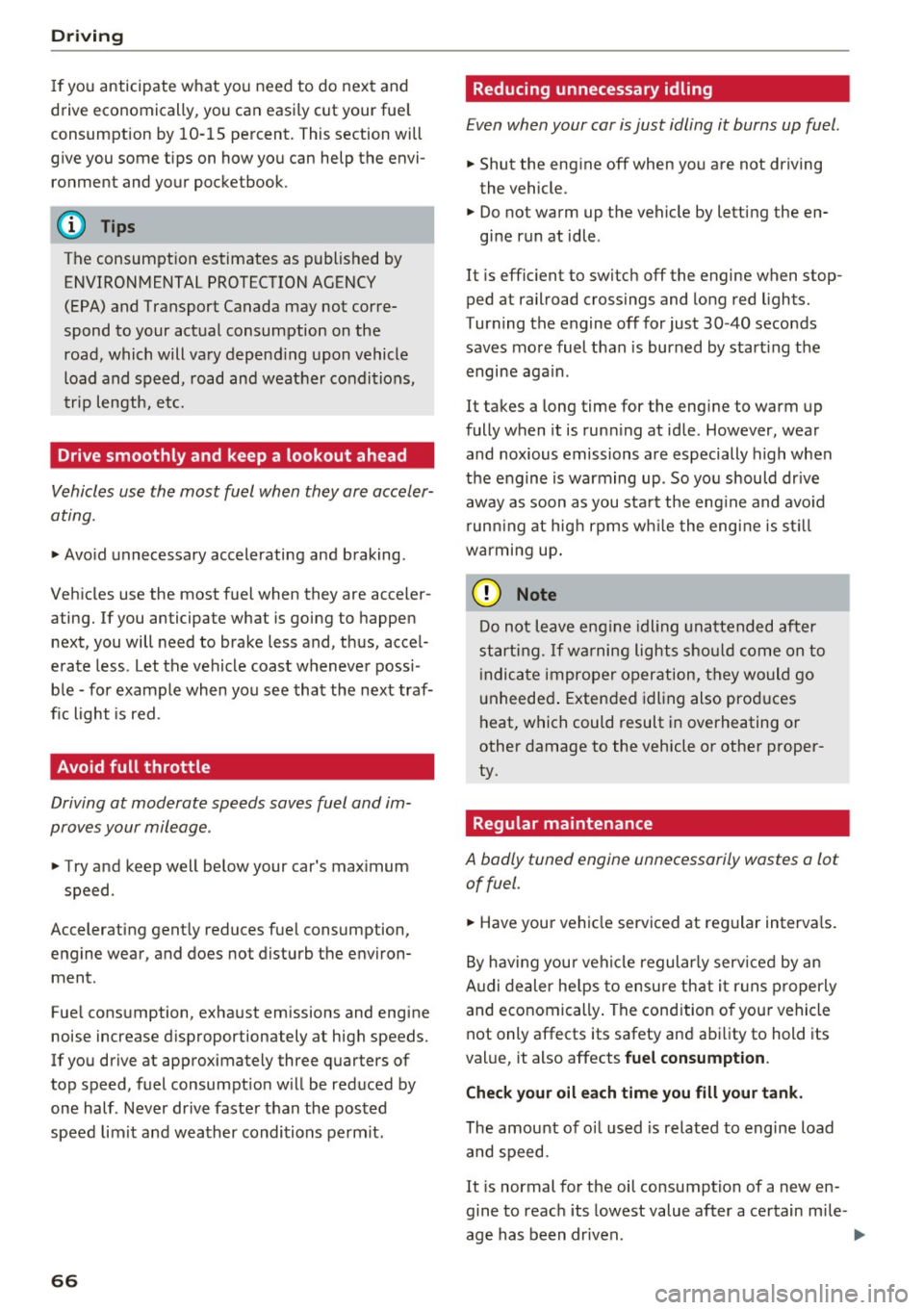
Driving
If you anticipate what you need to do next and
drive economically, you can easily cut your fuel
consumption by 10-15 percent. This section will
give you some tips on how you can help the envi ronment and your pocketbook.
(D Tips
The consumption estimates as published by ENVIRONMENTAL PROTECTION AGENCY
(EPA) and Transport Canada may not corre
spond to your actual consumption on the
road, which will vary depending upon vehicle
load and speed, road and weather conditions,
trip length, etc.
Drive smoothly and keep a lookout ahead
Vehicles use the most fuel when they are acceler
ating.
.. Avoid unnecessary accelerating and braking .
Vehicles use the most fuel when they are acceler
ating. If you anticipate what is going to happen next, you will need to brake less and, thus, accel
erate less. Let the vehicle coast whenever possi
ble -for example when you see that the next traf
fic light is red.
Avoid full throttle
Driving at moderate speeds saves fuel and im
proves your mileage.
.. Try and keep well below your car's maximum
speed .
Accelerating gently reduces fuel consumption,
engine wear, and does not disturb the environ ment.
Fuel consumption, exhaust emissions and engine
noise increase disproportionately at high speeds.
If you drive at approximately three quarters of
top speed, fuel consumption will be reduced by
one half . Never drive faster than the posted
speed limit and weather conditions permit.
66
· Reducing unnecessary idling
Even when your car is just idling it burns up fuel .
.. Shut the engine off when you are not driving
the vehicle .
.,. Do not warm up the vehicle by letting the en-
gine run at idle .
It is efficient to switch off the engine when stop
ped at railroad crossings and long red lights.
Turning the engine off for just 30 -40 seconds
saves more fuel than is burned by starting the
engine again .
It takes a long time for the engine to warm up
fully when it is running at idle . However, wear
and noxious emissions are especially high when
the engine is warming up . So you should drive
away as soon as you start the engine and avoid running at high rpms while the engine is still
warming up .
@ Note
Do not leave engine idling unattended after
starting. If warning lights should come on to
indicate improper operation, they would go
unheeded. Extended idling also produces
heat, which could result in overheating or
other damage to the vehicle or other proper
ty.
Regular maintenance
A badly tuned engine unnecessarily wastes a lot
of fuel.
.. Have your vehicle serviced at regular intervals.
By having your vehicle regularly serviced by an
Audi dealer helps to ensure that it runs properly
and economically. The condition of your vehicle
not only affects its safety and ability to hold its
value, it also affects
fuel consumption.
Check your oil each time you fill your tank.
The amount of oil used is related to engine load
and speed.
It is normal for the oil consumption of a new en
gine to reach its lowest value after a certain mile -
age has been driven . ..,.
Page 68 of 272
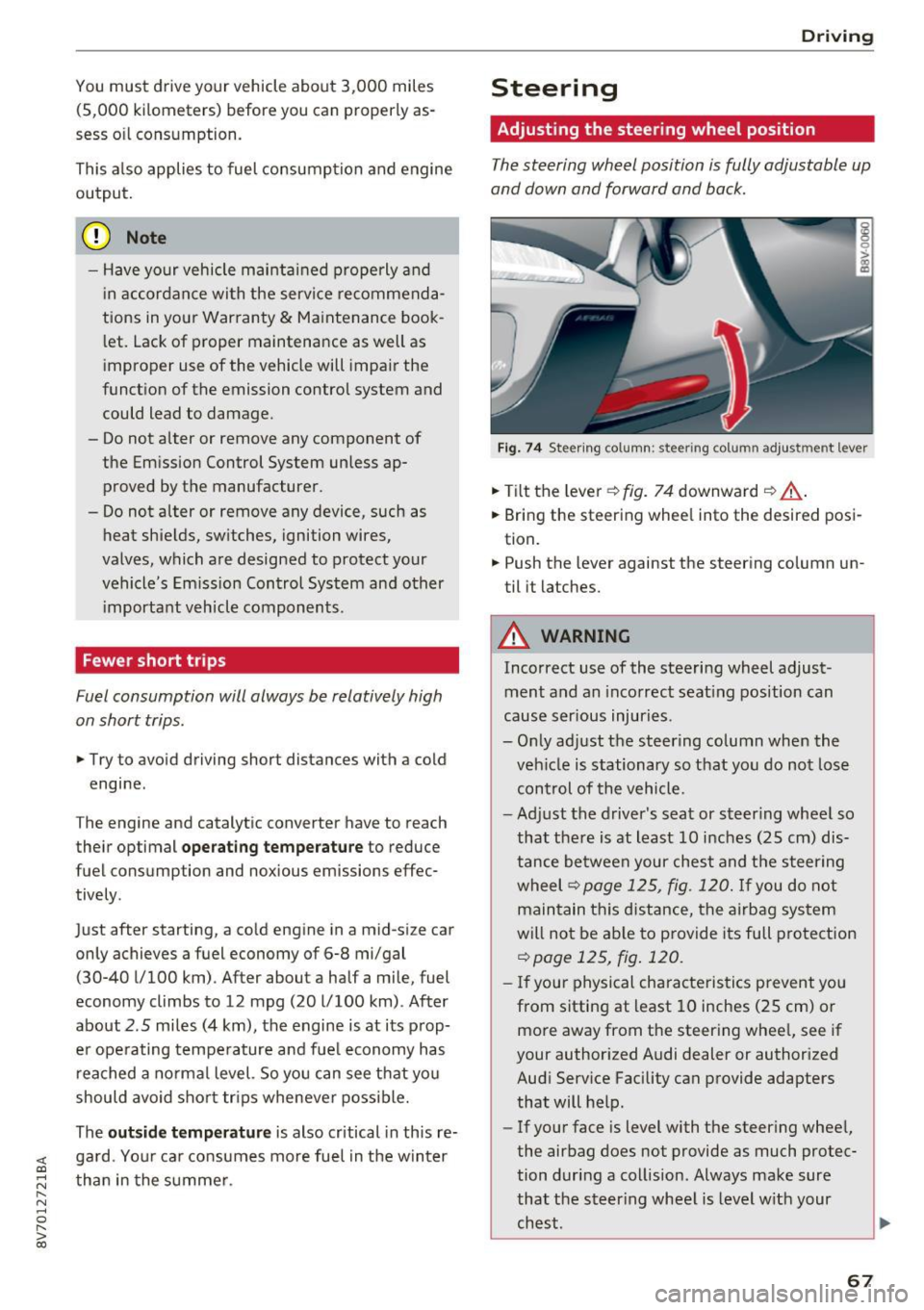
<( co ..... N
" N ..... 0
" > 00
You must drive your vehicle about 3,000 miles
(5 ,000 kilomet ers) before you can prop erly as
sess oil consumption .
This also applies to fuel consumption and engine output.
(D Note
- Have your vehicle maintained properly and
in accordance with the service recommenda
tions in your Warranty
& Maintenance book
let. Lack of proper maintenance as well as
improper use of the vehicle will impair the
function of the emission control system and
could lead to damage .
- Do not alter or remove any component of
the Emission Control System unless ap proved by the manufacturer.
- Do not alter or remove any device, such as
heat shields, switches, ignition wires,
valves, which are designed to protect your
vehicle's Emission Control System and other i mportant vehicle components.
Fewer short trips
Fuel consumption will always be relatively high
on short trips.
• Try to avoid driving short dist ances with a cold
engine .
T he eng ine and catalytic converter have to reach
their optimal
operating temperature to reduce
fuel consump tion and noxious emissions effec
tively .
Just after starting, a cold engine in a mid-si ze car
only achieves a fuel economy of 6-8 mi/gal (30-40 l/100 km) . After about a half a mile , fuel
economy climbs to 12 mpg (20 l/100 km) . After
about
2.5 miles (4 km), the engine is at its prop
er operating temperature and fuel economy has reached a normal level. So you can see that you
should avoid sho rt trips whenever possible.
The
outside temperature is also critical in this re
gard . Your car consumes more fuel in the winter
than in the summer .
Driving
Steering
Adjusting the steering wheel position
The steering wheel position is fully adjustable up
and down and forward and back.
Fig. 74 St ee ring co lumn: steering col umn adjus tmen t leve r
• Tilt the lever¢ fig. 74 downward ¢&_ .
• Bring the steering wheel into the desired posi
tion.
• Push the lever against the steering column un
til it latches.
A WARNING
-
Incorrect use of the steering wheel adjust ment and an incorrect seating position can
cause serious injuries .
- Only adjust the steering column when the
vehicle is stationary so that you do not lose control of the vehicle.
-
- Adjust the driver's seat or steer ing wheel so
that there is at least 10 inches (25 cm) dis
tance between your chest and the steering
wheel
r:!> page 125, fig. 120. If you do not
maintain this distance, the airbag system
will not be able to provide its full protection
r:!> page 125, fig. 120.
-If your physical characteristics prevent you
from sitting at least 10 inches (25 cm) or
more away from the steering wheel, see if
your authorized Audi dealer or authorized
Audi Service Facility can provide adapters
that will help.
- If your face is level with the steering wheel,
the airbag does not provide as much protec
tion during a collision . Always make sure
that the steering wheel is level with your
chest.
~
67
Page 88 of 272
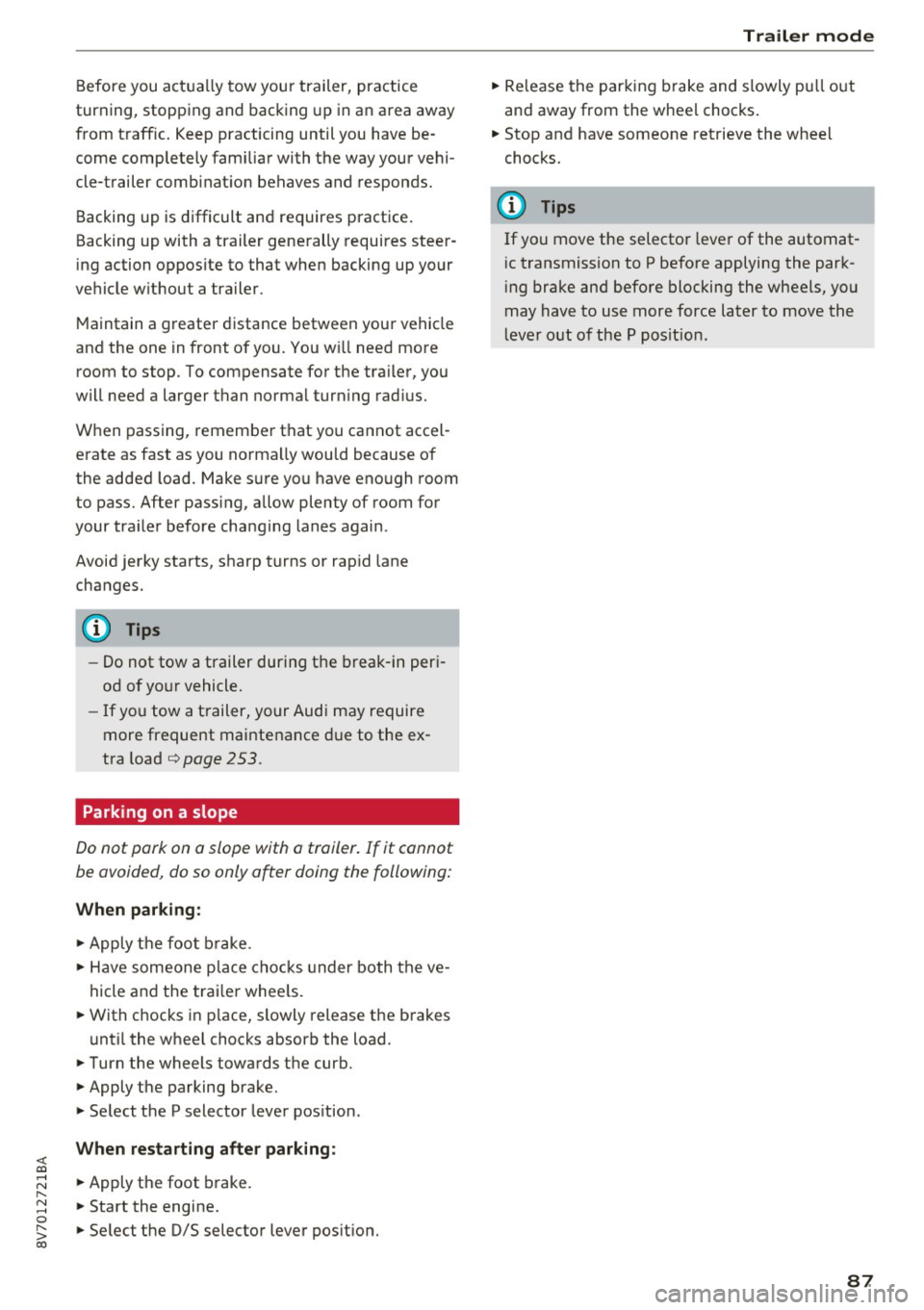
<( co .... N ,.__
N .... 0 ,.__
> co
Before you actually tow your trailer, practice
turning, stopping and backing up in an area away
from traff ic. Keep practicing until you have be
come completely familiar with the way your vehi
cle-trailer combination behaves and responds.
Backing up is difficult and requires practice.
Backing up with a trailer generally requires steer
ing action opposite to that when backing up your
vehicle without a trailer.
Maintain a greater distance between your vehicle
and the one in front of you. You wi ll need more
room to stop. To compensate for the trailer, you
will need a larger than normal turning radius.
When passing, remember that you cannot accel
erate as fast as you norma lly would because of
the added load. Make sure you have enough room
to pass. After passing, allow plenty of room for
your trailer before changing lanes again.
Avoid jerky starts, sharp turns or rap id lane
changes.
@ Tips
- Do not tow a trailer during the break-in peri
od of your vehicle.
- If you tow a trailer, your Audi may require
more frequent maintenance due to the ex
tra load
<=> page 2 53.
Parking on a slope
Do not pork on a slope with a trailer. If it cannot
be avoided, do so only ofter doing the following:
When parking:
.. Apply the foot brake .
.. Have someone pla ce chocks under both the ve
hicle and the trailer wheels .
.. With chocks in place, slowly release the brakes
until the wheel chocks absorb the load .
.. Turn the wheels towards the curb .
.. Apply the parking brake .
.. Select the P selector lever position.
When restarting after parking :
.. Apply the foot brake.
.. Start the engine .
.. Select the D/S selector lever position.
Trailer mode
.. Release the parking brake and slowly pull out
and away from the wheel chocks.
.. Stop and have someone retrieve the whee l
chocks.
{!) Tips
If you move the selector lever of the automat
ic transmission to P before applying the park
ing brake and before blocking the wheels, you
may have to use more force later to move the
lever out of the P posit ion.
87
Page 159 of 272

<( co ..... N
" N ..... 0 r--. > 00
must be performe d by qualified workshops
only. Make sure that any airbag service ac
tion is entered in your Audi Warranty
&
Maintenance booklet under AIRBAG RE
PLACEMENT RECORD.
- For safety reasons in severe accidents, the
alternator and starter are separated from
the vehicle battery with a pyrotechn ic circuit
interrupter.
- Work on the pyrotechnic circ uit interrupt
er must only be performed by a qualified
technicians who have the experience, in
formation and special tools necessary to
perform the work safely.
- If the veh icle or the c ircuit interrupter is
scrapped, all app licable safety precautions
must be followed .
@) For the sake of the environment
Undeployed airbag modu les and pretension
ers might be classified as Perch lorate Materi
al - special handling may apply, see
www.dtsc .ca.gov/hazardouswaste/perchlo
rate. When the veh icle or parts of the re
strai nt system including airbag modules and
safety bel ts wit h pretensione rs are scrapped,
all a ppli cable laws and regulations mus t be
observed. Your a uthorized Audi dealer is fa
m iliar with these requirements and we recom
mend that you have your dealer perform this
service for you.
Other things that can affect Advanced
Airbag performance
Changing the vehicle's suspension system can
change the way that t he Advanced Airbag System
pe rforms in a crash. For examp le, using tire-r im
comb inat ions no t approved by Audi, lowering the
ve hicle, changing the s tiffness of the suspens ion,
includ ing the springs, suspension struts, shock
absorbers etc . can change the forces that are
measured by the airbag sensors and sent to the
e lectronic contro l unit . Some suspens ion changes
can, for example, increase the force levels meas
ured by the sensors and make the airbag system
deploy in crashes in wh ich it would not dep loy if
the changes had no t been made. Other kinds of
Airb ag sys tem
changes may red uce the force levels measured by
the sensors and prevent the airbag from deploy
i ng when it sho uld.
A WARNING
=
Changing the vehicle's suspension including
use of unapproved tire-rim combinations can
change Advanced Airbag performance a nd in
crease the risk of serious personal injury in a
crash.
- Never install suspension components that do not have the same performance charac
ter istics as the components origina lly instal
led on you r vehi cle.
- Never use tire-rim combinations that have
not been approved by Audi.
Knee airbags
Description of knee airbags
Applies to: vehicles wi th knee airbags
The knee airbag system can provide supplemen
tal protection to properly restrained front seat
occupants .
Fig. 14 1 Driver 's k nee a irbag
The driver knee airbag is in the instrument panel
underneath the s teer ing whee l
~fig. 141, the
airbag fo r the passenger is at abou t the same
heig ht in the i nstr ume nt p ane l underneath the
glove compa rtment.
The knee airbag offers add itiona l protection to
t h e d river's and passenge r's knees and uppe r and
l ower thigh areas a nd supplements the p rotec
t ion prov ided by the safety bel ts .
If the front airbags deploy, the knee a irbags also
deploy in frontal coll is ions when the deploymen t
Iii--
159
Page 188 of 272

Checking and Filling
"'Never put too much motor oil in your engine
¢ page 193 , Checking the engin e oil lev el and
adding oil.
"'Never try to push- or tow-star t your vehicle.
The catalytic converter is an efficient "clean-up"
device built into the exhaust system of the v ehi
cle. The catalytic converter burns many of the pollutants in the exhaust gas before they are re
leased into the atmosphere .
The exclusive use of unleaded fuel is critically im
portant for the life of the catalytic converter and
proper functioning of the engine.
A WARNING
The temperature of the exhaust system is
high, both when driving and after stopping
the engine.
-
- Never touch the exhaust tail pipes once they
have become hot . This could result in burns .
- Do not park or operate the vehicle in areas
where the hot exhaust system may come in
contact with dry grass, brush , fuel spill or
other material which can cause a fire.
- Do not apply additional undercoating or
rustproofing on or near the exhaust mani
fold, exhaust pipes, catalytic converter or heat shields. During driving, the substance
used for undercoating could overheat and
cause a fire.
(D Note
- Be aware that just one tank filling with
leaded fuel will already seriously degrade
the performance of the catalytic converter.
- Do not exceed the correct engine oil level
¢page 193.
-Do not drive until the fuel tank becomes
completely empty. The engine could mis
fire. Unburned fuel could also get into the
exhaust system and this could cause the
catalytic converter to overheat.
- Do not switch off the ignition while the vehi
cle is moving.
- Do not continue to operate your vehicle un
der these conditions, as otherwise fuel can reach the catalytic converter. This could re-
188
sult in overheating of the converter, requir
ing its replacement.
- To assure efficient operation of the Emis
sion Control System:
- Have your vehicle maintained properly and
in accordance with the service recommen
dations in your Warranty
& Maintenance
booklet.
- Lack of proper maintenance as well as im
proper use of the vehicle will impair the
function of the emission control system
and could lead to damage.
@ For the sake of the environment
Even when the Emission Control System is op
erating properly, the exhaust gas can have a
sulfur-like exhaust gas smell under some op
erating states. This depends on the sulfur
content of the fuel being used. Using a differ
ent brand of fuel may help, or filling the tank
with lead-free super grade gasoline.
Engine compartment
Working in the engine compartment
Special care is required if you are working in the
engine compartment
For work in the engine compartment, such as
checking and filling fluids, there is a risk of in
jury, scalding, accidents, and burns. For this
reason, follow all the following listed warnings
and general safety precautions. The engine
compartment is a dangerous area.
£:=? &. -
A WARNING
To reduce the risk of injuries, complete the
following steps before opening the hood:
- Turn the engine off.
- Switch the ignition off.
- Set the parking brake.
- Place the selector lever in the P position .
- Let the engine cool down .
- Never open the hood when you see that
steam or coolant drips from the engine
compartment- there is a danger of burns!
Wait until no steam or coolant flows out .
-
Page 192 of 272
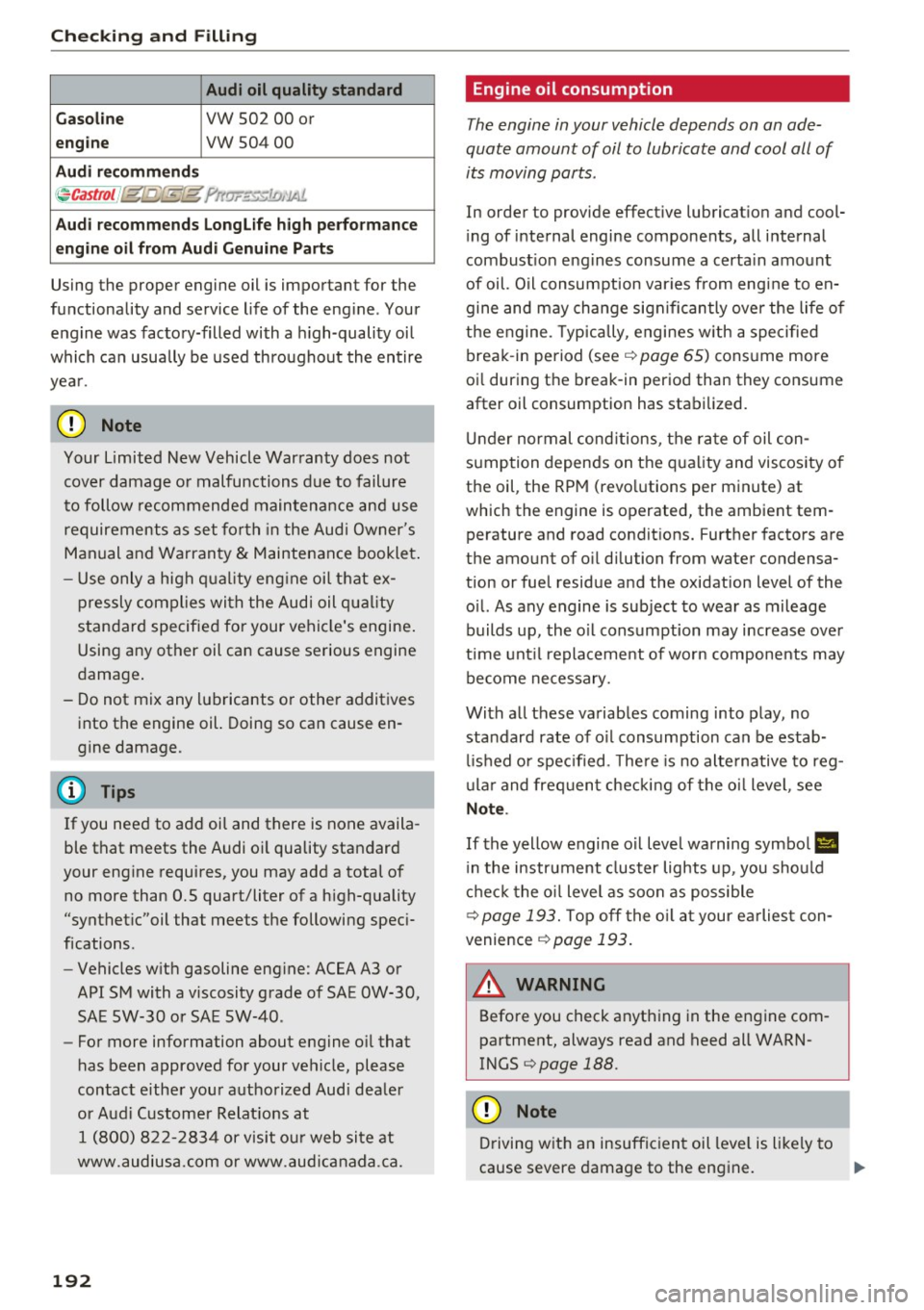
Check ing and F illing
Audi oil quality standard
Gas olin e
VW 502 00 or
engi ne vw 50400
A udi reco mmend s
~Castrol I jgl[J,'fE{g ?r,w.:..~J ri, '.IA!,
Audi rec ommends Longlif e high perform ance
engi ne oil from Au di Genuin e Parts
Using the proper engine oil is important for the
functionality and service life of the engine. Your
engine was factory-filled with a h igh-quality oil
which can usually be used throughout the entire
yea r.
(D Note
Your Limited New Vehicle Warranty does not
cover damage or malfunctions due to failure
to follow recommended maintenance and use
requirements as set forth in the Audi Owner's
Manual and Warranty & Maintenance booklet .
- Use only a high qual ity eng ine oil that ex-
pressly complies with the Audi oil quality
standard specified for your vehicle's engine .
Using any other oil can cause serious engine
damage.
- Do not mix any lubricants or other additives into the engine oil. Doing so can cause en
gine damage.
@ Tips
If you need to add oil and there is none availa
ble that meets the Audi oil quality standard
your engine requires, you may add a total of
no more than 0.5 quart/liter of a h igh-quality
"synthet ic"oil that meets the following speci
fications.
- Vehicles w ith gasoline eng ine: ACEA A3 or
API SM with a viscosity grade of SAE OW-30,
SAE 5W-30 or SAE 5W-40.
- For more information about engine o il that
has been approved for your vehicle, please
contact either your authorized Audi dea ler
or Aud i Custome r Relat ions at
1 (800) 822- 2834 or visit ou r web site at
www.audiusa.com or www .aud icanada.ca.
192
· Eng ine oil consumption
The engine in your vehicle depends on an ade
quate amount of oil to lubricate and cool all of
its moving parts.
In order to provide effect ive lubricat ion and cool
i ng of internal engine components, all internal
combust ion eng ines consume a certa in amount
of oil. Oil consumption var ies from engine to en
gine and may change sign ificantly over the life of
the engine . T ypically, engines w ith a specified
break -in period (see¢
page 65) consume more
oi l during the break-in period than they consume
after oil consumption has stabilized.
U nder normal cond itions, the rate of oil con
sumption depends on the quality and viscosity o f
the oil , the RPM (revo lutions per minute) at
which the engine is operated, the ambient tem perature and road conditions. Further factors are
the amount of o il dilution from water condensa
tion or fuel residue and the oxidation level of the
o il. As any engine is subject to wear as mileage
builds up, the o il consumption may increase over
ti me unt il replacement of wo rn compo nents may
become necessary.
With all these variables coming into play, no standard rate of o il consumption can be estab
li shed or spec ified . T he re is no alte rnative to reg
u la r and freq uent checki ng of the oi l level, see
Note.
If the yellow engine oil level warning symbo l II
in the instrument cluster lights up, you sho uld
chec k the o il level as soon as possible
¢
page 193. Top off the o il at your earlies t con
venience
¢ page 193.
A WARNING
Before you check anything in the engine com
partment, always read and heed all WARN
INGS
¢page 188.
(D Note
Driving with an insufficient oil level is likely to
cause severe damage to the engine.
IJII,